The Crescent Moon Plays Planetary Hopscotch, Falling Back, Wading into Water Constellations, and Some Spooky Treats!
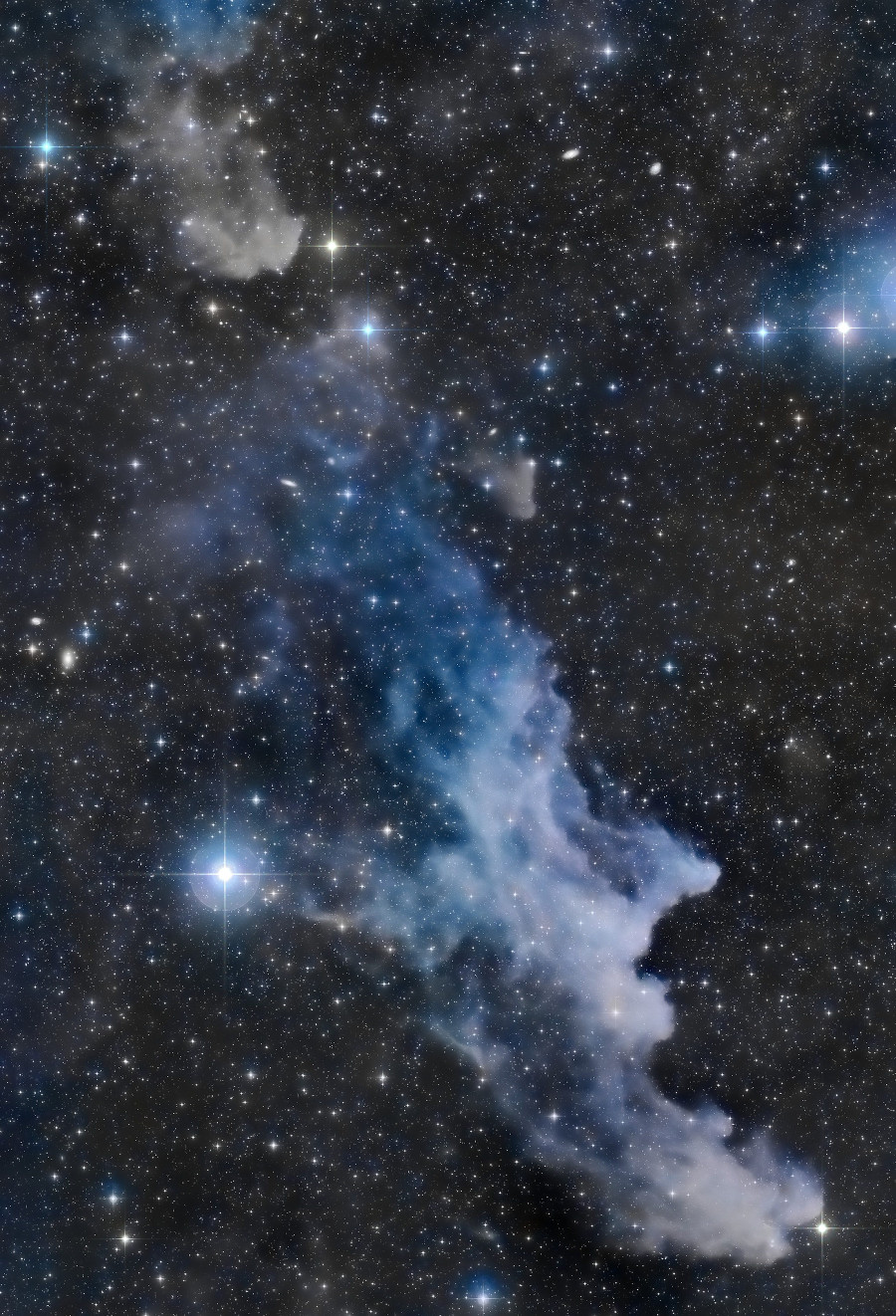
The Witchhead Nebula in Orion is very large, but dim. It’s best seen in long exposure astrophotos – like this image taken by Jeff Signorelli in the NASA APOD for October 30, 2015. The name is a misnomer. The blue colour is produced when light from the bright star at centre left reflects off nearby interstellar dust grains – not gas.
Hello, late-October Stargazers!
Here are your Astronomy Skylights for the week of October 27th, 2019 by Chris Vaughan. Feel free to pass this along to your friends and send me your comments, questions, and suggested topics. I repost these emails with photos at http://astrogeo.ca/skylights/ where all the old editions will be archived. You can also follow me on Twitter as @astrogeoguy! Unless otherwise noted, all times are Eastern Time. To subscribe to these emails please click this MailChimp link.
I can bring my Digital Starlab portable inflatable planetarium to your school or other daytime or evening event. Contact me through AstroGeo.ca, and we’ll tour the Universe together!
The overnight sky will remain nice and dark for most of this week, allowing us to view some spooky sights and tour the 2nd dimmest constellation, Capricornus. The bright evening planets will be “exiting – stage west”, too. The moon will return to the evening sky worldwide and hop over those bright planets. Meanwhile, Earth’s nearest planets, Venus and Mars, will continue to improve in visibility as they increase their distances from the evening and morning sun, respectively. Here are your Skylights!
It’s Time to Fall Back
Don’t forget to set your clocks back one hour next Saturday night! To be honest – we astronomers kind of love the end of Daylight Savings Time every autumn. Presto – on Sunday, November 3, the sky becomes dark enough for observing right after dinner!
In fact – we’d like to abolish DST. In late June and July, we have to wait until nearly midnight for the sky to get dark enough to observe faint fuzzies. And just when the weather is getting nice enough to host spring star parties for school kids in March, the clocks go forwards – and then we can’t start the serious stargazing until their bedtime!
The times of most astronomical events are expressed in Greenwich Mean Time (GMT) or its equivalent, Universal Time (UT). That’s because many events (like lunar eclipses) are visible across many time zones. To convert a GMT or UT event to your local time zone, you have to add or subtract the correct number of hours. Eastern Standard Time (EST) is normally five hours behind GMT. But during the Daylight Savings Time period, Eastern Daylight Time (EDT) is only four hours different.
The Moon and Planets
Shortly before midnight tonight (Sunday), the New Moon phase will occur. At its new phase, the moon is travelling between Earth and the sun. Since sunlight can only reach the far side of the moon, and the moon is in the same region of the sky as the sun, the moon will be completely hidden from view. This also yields dark night-time skies worldwide.
The beautiful, young crescent moon will re-appear low over the western horizon right after sunset sky on Monday, and then it will wax and climb higher every evening thereafter. In the southwestern sky after sunset on Tuesday, the moon will be positioned only four finger widths above (or to the celestial northeast of) the bright planet Venus. Both objects will fit within the field of view of binoculars.
On Wednesday and Thursday (Halloween), in a darker sky, the moon will hop over bright Jupiter – starting at Jupiter’s lower right on Wednesday and then moving to the planet’s upper left on Thursday. On Friday and Saturday night, the moon will do a similar manoeuvre with Saturn – above the stars of Sagittarius (the Archer). Next Sunday night, the nearly half-illuminated moon will land in Capricornus (the Sea-Goat).
Mercury and Venus will continue to occupy the western, post-sunset sky this week, but Mercury is descending sunward and fading from view every night. At the same time, Venus will continue to draw farther from the sun – but the shallow evening ecliptic will prevent Venus from climbing above the glare of sunset for a while longer. Venus’ bright magnitude -3.85 brilliance will make it fairly easy to spot for a brief period after sunset, if you can find a low open horizon to the west-southwest. The planet will set at 7 pm local time.

You can use Venus to find much dimmer Mercury. Low in the southwestern sky on the evenings around Wednesday, October 30, speedy Mercury’s motion sunward will carry it past much brighter Venus. At closest approach on October 30, Mercury will be positioned 2.5 finger widths to the lower left (or to the celestial south) of Venus, allowing both planets to appear together in the field of view of binoculars.
Jupiter will be setting in the west at about 8:45 pm local time this week, but the earlier-arriving sunsets of October are still giving us time to view the spectacularly bright planet, albeit through a LOT of intervening atmosphere. As the sky begins to darken this week, look for the giant planet sitting about 1.5 fist diameters above the southwestern horizon. On Halloween evening, the waxing crescent moon will be positioned four finger widths to the upper left (or celestial east) of Jupiter. The pair will fit together in the field of view of binoculars.
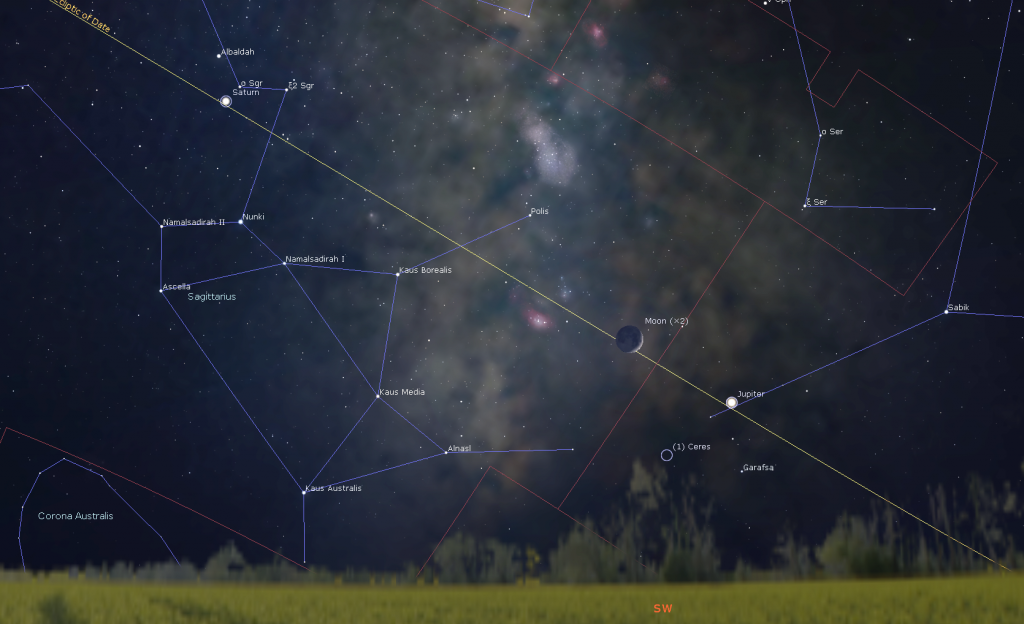
Yellow-tinted Saturn is still a very good option for backyard telescopes. It’s in the southern evening sky – and is rather less bright than Jupiter. The ringed planet will be visible from dusk, when it will be about two fist diameters above the southern horizon, until after 10 pm local time. Saturn’s position is just to the upper left (or celestial east) of the stars that form the teapot-shaped constellation of Sagittarius (the Archer) and about 2.5 fist diameters to the upper left (or celestial east) of Jupiter.
A look at Saturn is well worth dusting off your old telescope! Once the sky is dark, even a small telescope will show Saturn’s rings and several of its brighter moons, especially Titan! Because Saturn’s axis of rotation is tipped about 27° from vertical (a bit more than Earth’s axis), we can see the top surface of its rings, and its moons can arrange themselves above, below, or to either side of the planet. During this week, Titan will migrate counter-clockwise around Saturn, moving from the lower right of Saturn tonight (Sunday) to above the planet next Sunday. (Remember that your telescope will flip the view around.)

Distant and dim, blue Neptune is visible all night long among the stars of eastern Aquarius (the Water-Bearer), and is less than a finger’s width to the right (or celestial west) of a medium-bright star named Phi (φ) Aquarii. Both blue Neptune and that golden-coloured star will appear together in the field of view of a backyard telescope at medium power. The distance between the star and the planet is steadily increasing due to Neptune’s westward retrograde orbital motion. I posted a diagram of Neptune’s position compared to that star here.
Blue-green Uranus will reach opposition on Monday, October 28. On that night it will be closest to Earth for this year – 2.8 billion km or 157 light-minutes. Its minimal distance from Earth will cause it to shine at a peak brightness of magnitude 5.7 and to appear slightly larger in telescopes. At opposition, planets are visible all night. If you can wait until midnight to view it, you’ll be looking through the least amount of Earth’s atmosphere.
Right now, Uranus is sitting below (or to the celestial south of) the stars of Aries (the Ram) and is just a palm’s width above the circlet of stars that form the head of Cetus (the Whale). Uranus is actually bright enough to see in binoculars and small telescopes under dark skies. You can use the three modest stars that form the top of the head of the whale (or sea-monster in some tales) to locate Uranus for the next several months – because the distant planet moves so slowly in its orbit. To help you find it, I posted a detailed star chart here.
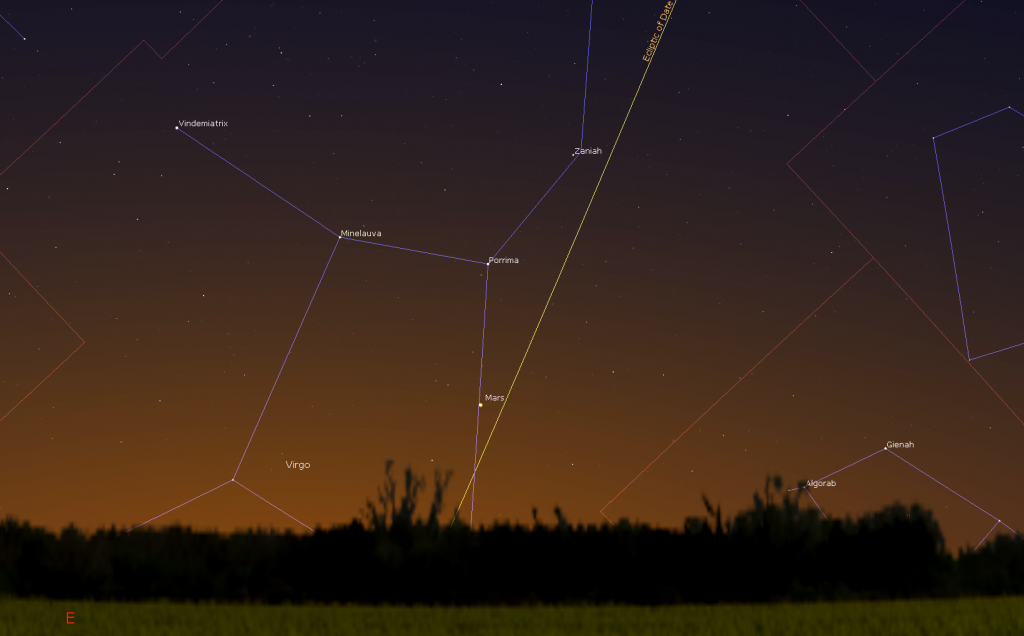
Mars is still pulling away from the sun’s glare in the eastern pre-dawn sky. It rises at about 6:05 am local time and will become more easily visible next month. Unfortunately, the red planet is on the far side of the sun from us – so it will remain rather small and faint until early next year.
For several evenings commencing on Saturday, November 2 the orbital motion of the large asteroid Vesta carry it closely past the medium-bright star Omicron (o) Tauri, which marks Taurus the Bull’s hoof – setting up an easy way to find and view the magnitude 6.6 asteroid. The pair of objects will appear together in the field of view of a telescope at medium magnification. Closest approach of 20 arc-minutes (or two-thirds of the moon’s diameter) will occur on November 4. In binoculars, Vesta will be positioned below the star – and some telescopes will flip that view.

Halloween Treats
It’s time to seek out some spooky treats in honour of Halloween. The Skull Nebula (also designated NGC246) in Cetus (the Whale) is located in the southeastern sky in mid-evening. This planetary nebula’s oval shape and dark voids within it resemble a skull. For a challenge, try to spot Mirach’s Ghost (NGC 404), a magnitude 11.7 galaxy tucked just above the bright star Mirach in Andromeda (the Princess).
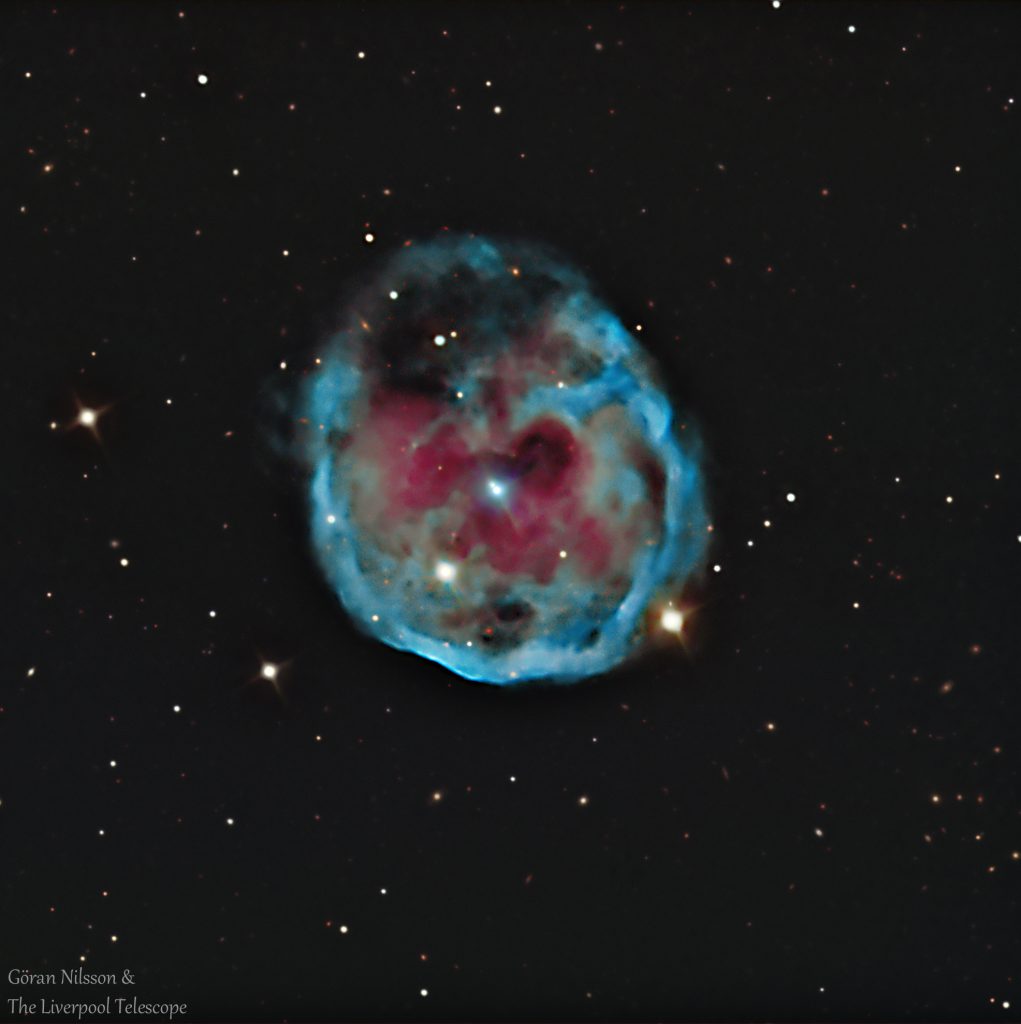
Night owls can try for the Witch Head Nebula (NGC 1909), which will be rising after 10 pm local time this week. This object is actually a reflection nebula – the light from a bright is scattering off of the interstellar dust that it is embedded within – making the same type of blue we see in the sky in daytime. The object is large, too – it measures 3 finger widths high by 1 finger width across. It is centred 2.5 finger widths to the upper right (or to the celestial east) of the bright star Rigel in Orion (the Hunter). It’s a bit dim to see visually, but I posted a fantastic photograph above.
The Water Constellations – Capricornus the Sea-Goat
Late October evenings feature an interesting grouping of constellations over the southern horizon – the water constellations. They aren’t very prominent, consisting mainly of dim stars, but this week’s moonless sky will offer an opportunity to see them better. Over the next few weeks, I’ll tour you through more of them.
First up, literally, is Capricornus (the Sea-Goat), the second dimmest constellation of the heavens. This most westerly of the water constellations rises first and sets first, at about midnight local time this week – so it’s nicely positioned for viewing as soon as it’s dark outside.
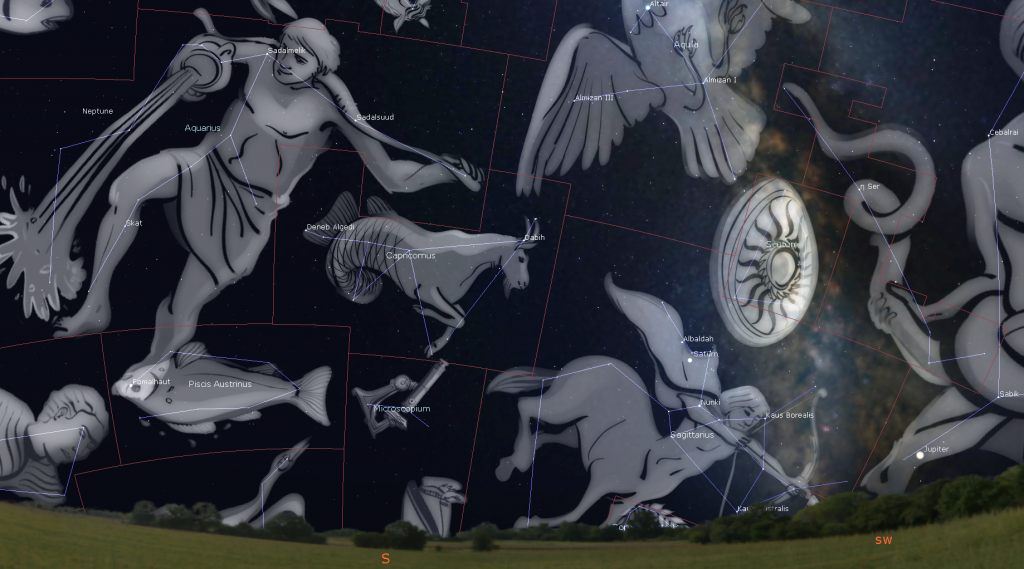
This zodiac constellation sits squarely on the ecliptic. The Teapot-shaped stars of Sagittarius (the Archer) is a good starting point to find it. In late October Capricornus will sit less than a third of the way up the southern sky after dusk. The main stars of Capricornus cover a patch of sky that is 20° (or two fist diameters) across – and the middle of the Sea-Goat is positioned 30° to the upper left (or to the celestial east) of the Teapot. I’ll post a sky chart here.
The constellation consists of about nine modest-brightness stars arranged in a wedge or boat-shape, or perhaps a bikini bottom. Various star atlases and astronomy apps join up the stars differently. The brightest star, designated Alpha Capricorni, sits at the upper right (northwestern) corner of the constellation. It is also known as Giedi or Al Giedi, roughly translated as “the billy goat”. This star is a nice wide double star easily discerned with unaided eyes, but the two stars are only a line-of-sight double. The nearer star is about 100 light-years away, while the farther one is almost 700 light-years away! Both stars are orange-yellow, about as hot as the sun. The Chinese call this star 牛宿二 (Niú Sù èr), the Second Star of the Ox.
About two finger widths below Giedi is another easy double star named Dabih “lucky star of the slaughterer”, that should readily split apart in binoculars. At the opposite eastern hip of the bikini sits the brighter star Deneb Algedi “tail of the goat”. If you scan the sky about a palm’s width below and a little to the west of Deneb Algedi, you should be able to spot a small fuzzy patch that is the globular star cluster Messier 30, which orbits our galaxy and is 8,000 light-years away from our sun.
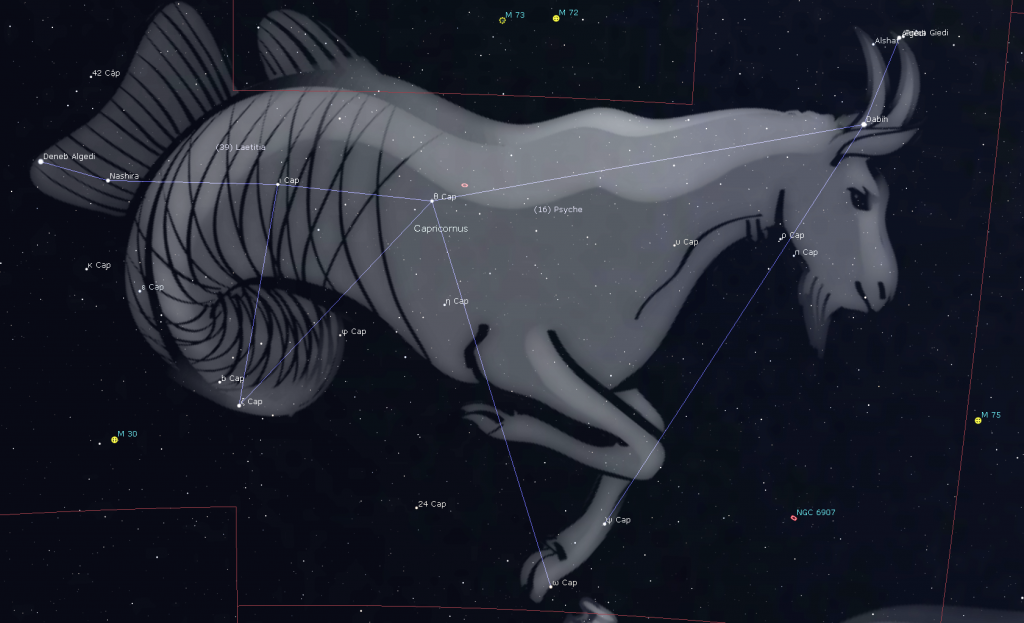
In Greek mythology, Capricornus represents the goat-like god Pan, who fled into the sea to escape a monster, whereby his legs were transformed into a fish tail. The ancient Sumerians, Babylonians, and the Romans all envisioned the same creature in these stars. The Tropic of Capricorn is the southern latitude where the sun shines directly overhead on the Winter Solstice. It is called that because, many years ago, at the winter solstice, the sun was among those stars. Nowadays the sun is in neighboring Sagittarius on the solstice.
Orionid Meteor Shower
The annual Orionids Meteor Shower, derived from material left by repeated passages of Comet Halley, continues until November 14. Although we’re well past the peak night, this week’s moonless evenings are good opportunities to spot some leftover Orionids. The meteors can appear anywhere in the sky, but will be moving in a direction away from a location (the radiant) above the bright red star Betelgeuse in the constellation of Orion (the Hunter).
Binocular Dark Night Delights
If you missed last week’s note about seeing the deep sky gems scattered along the winter Milky Way – and more with binoculars, I posted it here.
Public Astro-Themed Events
Taking advantage of dark, moonless evening skies this week, astronomers with the RASC Toronto Centre will gather for dark sky stargazing at Long Sault Conservation Area, northeast of Oshawa on (only) the first clear evening (Monday to Thursday) this week. You don’t need to be a RASC member, or own any equipment, to join them. Check here for details and watch the banner on their homepage or their Facebook page for the GO or NO-GO decision around 5 pm each day.
Every Monday evening, York University’s Allan I. Carswell Observatory runs an online star party – broadcasting views from four telescopes/cameras, answering viewer questions, and taking requests! Details are here. On Wednesday nights they offer free public viewing through their rooftop telescopes, including their brand new 1-metre telescope! If it’s cloudy, the astronomers give tours and presentations. Registration and details are here.
On Tuesday, October 29 at 7 pm at the Parkdale Library, CBC’s Bob McDonald will present a free public talk about his latest book An Earthling’s Guide to Outer Space. Details are here.
On Wednesday, October 30 at 7 pm at the Oakville Centre, CBC’s Bob McDonald will present a public talk about his latest book An Earthling’s Guide to Outer Space. Tickets and details are here.
On Wednesday, October 30 at 7 pm in U of T’s Lash Miller Chemical Laboratories (LM), Room 161, U of T’s Astronomy & Space Exploration Society will present a free talk by professor Jeremy Webb, who will be illuminating the nature of globular clusters, and how we can use them to better understand galaxies – followed by stargazing through telescopes (weather permitting). Details are here.
On Thursday, October 31 at 6:30 pm at the Malvern Library, U of Toronto’s Dr. Mubdi Rahman will present a free public talk about Islamic Heritage Month. Details are here.
If it’s sunny on Saturday morning, November 2 from 10 am to noon, astronomers from the RASC Toronto Centre will be setting up outside the main doors of the Ontario Science Centre for Solar Observing. Come and see the Sun in detail through special equipment designed to view it safely. This is a free event (details here), but parking and admission fees inside the Science Centre will still apply. Check the RASC Toronto Centre website or their Facebook page for the Go or No-Go notification.
This Fall and Winter, spend a Sunday afternoon in the other dome at the David Dunlap Observatory! On Sunday afternoon, November 10, from noon to 4 pm, join me in my Starlab Digital Planetarium for an interactive journey through the Universe at DDO. We’ll tour the night sky and see close-up views of galaxies, nebulas, and star clusters, view our Solar System’s planets and alien exo-planets, land on the moon, Mars – and the Sun, travel home to Earth from the edge of the Universe, hear indigenous starlore, and watch immersive fulldome movies! Ask me your burning questions, and see the answers in a planetarium setting – or sit back and soak it all in. Sessions run continuously between noon and 4 pm. Ticket-holders may arrive any time during the program. The program is suitable for ages 3 and older, and the Starlab planetarium is wheelchair accessible. For tickets, please use this link.
Keep looking up, and enjoy the sky when you do. I love questions and requests – so, send me some!